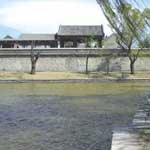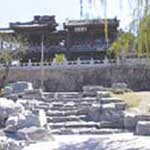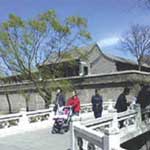 |
 |
|
Taoranting, Park of Ecstasy
By Shida Zhu (Beijing Today)
Updated: 2004-04-13 09:53
 The site of today's Taoranting Park was the eastern urban
district of the capital, Dadu, of the Jin Dynasty and imperial brick kilns
during the Ming and Qing dynasties. The site of today's Taoranting Park was the eastern urban
district of the capital, Dadu, of the Jin Dynasty and imperial brick kilns
during the Ming and Qing dynasties.
During
the Yuan, Ming and Qing, court officials and rich men built their private
gardens there. Jiang Zao, the Minister of Industry during the reign of Emperor
Kangxi, who was in charge of the brick kilns, built three houses at the Zibei
Temple (the Temple of Mercy) south of the kiln. He named the compound
"Taoranting" (the Garden of Ecstasy) after famous Tang poet Bai Juyi¡¯s poem:
When the chrysanthemums turn yellow and wine is made,
Lo! my
dear friend,
Let¡¯s drink to our heart¡¯s content and be drunken away
In
ecstasy.
The site that covered the Black Dragon Pond the east,
Dragon Spring Temple in the west, Nanheng Street in the north and the city wall
in the south later became an attraction for tourists from far away and those
scholars who came to the nation¡¯s capital for imperial civil examinations.
Most famous at the site was the Plum Garden northeast of the Garden of
Ecstasy and northwest of the Black Dragon Pond. Scholars and literati of the
Ming and Qing dynasties often came there to drink wine and compose poems. Cao
Zhenji, a poet of the Qing, once sang of the garden:
When
the plum has not yet come to bloom,
I invite friends to come;
The leaves
falling like in dreams,
We toast under the pine tree.
 Northwest of the Garden of Ecstasy was an ancient garden,
the Garden of the Fengs, built in 1122, the sixth year of the reign of Emperor
Tianfu of the Jin Dynasty and declined in 1722, the 61st year of the reign of
Emperor Kangxi. Though it decayed, some of the ancient pine trees still stood,
attracting many a poet. Northwest of the Garden of Ecstasy was an ancient garden,
the Garden of the Fengs, built in 1122, the sixth year of the reign of Emperor
Tianfu of the Jin Dynasty and declined in 1722, the 61st year of the reign of
Emperor Kangxi. Though it decayed, some of the ancient pine trees still stood,
attracting many a poet.
At Nanbanjie Hutong on Nanheng Street was the
Garden of Ease, locally dubbed the Seven-Building Garden, the private garden of
Yan Song, a high-ranking official of the Ming Dynasty and later Wang Xi, a great
court official and scholar of the Qing. The garden covered the most part of the
street and transcended over the southern, western and northern parts of the
city.
Most outstanding of the garden¡¯s sights was the grotesque
formation of Taihu Lake rocks designed by Zhang Ran of Huating. Zhang Ran
desiged the rock formations at such famous imperial gardens as the Yingtai at
Zhongnanhai, Changchunyuan (later the Summer Palace) and Yuquan Hill.
Northwest
of the Garden of Ecstasy and southeast of the Dragon Spring Temple was an
ancient temple called Longzhuahuai noted for two Dragon Claw Chinese scholar
trees.
 The current earthen mound on the north of today's
Taoranting Park was the site of an imperial kiln called Blac Kiln. It made
ordinary bricks and tiles for the building of imperial palaces during the reign
of Emperor Yongle of the Ming. As feudal emperors who had superstitious ideas
about fengshui forbade excavation of soil for brick making in the imperial city
proper, the kiln had to get its soil from the sandy hill. The current earthen mound on the north of today's
Taoranting Park was the site of an imperial kiln called Blac Kiln. It made
ordinary bricks and tiles for the building of imperial palaces during the reign
of Emperor Yongle of the Ming. As feudal emperors who had superstitious ideas
about fengshui forbade excavation of soil for brick making in the imperial city
proper, the kiln had to get its soil from the sandy hill.
In the 281
years from the 18th year of the reign of Emperor Yongle of the Ming to the 33rd
year of the reign of Emperor Kangxi of the Qing, the hill had almost been
leveled. Officials in charge of the imperial kiln built a temple there for the
worship of the God of Fire.
Today¡¯s
Taoranting Park still retains many ancient traces. On the goud-shaped islet in
between the Eastern and the Western lakes stands the Temple of Mercy, built on a
raised rocky platform during the Yuan Dynasty. The temple is a standard
traditional quadrangle (sihe) courtyard with pavilions on the east, south, west
and north. The western and northern pavilions each had three rooms. The western
pavilion was the original Taoranting.
During the reign of Emperor Kangxi
of the Qing Dynasty, the Black Kiln was still in operation and there were two
supervisors, one Manchurian and one Han. The Han supervisor was Jiang Zao, a
native of Hanyang, Hubei province, a Minister of Industry of the court. He was a
poet and calligraphic master.
At the gate of the temple was a
calligraphic work in gold of Taoran by Jiang Zao and on the temple wall were
inset with a rock carving, ¡°Ode to Taoranting¡± that sang in the last two verses:
Sorry
that I'm not a painter
To draw a picture of listening to the cascading
spring
In deep Autumn night.
The temple wall was also inset with
the calligraphic work ¡°Urban Forest¡± by Wang Yushu.
Southwest of the
gourd-shaped islet was a two-storied pavilion, respectively named Cloud-painted
Tower and Pure-sound Chamber. The pavilion, built during the reign of Emperor
Qianlong of the Qing, was originally at the eastern bank of Nanhai, the southern
lake. Zhou Enlai suggested moving the pavilion out of Nanhai to Taoranting Park
in 1954.
On January 18, 1920, Mao Zedong met with his revolutionary
friend Deng Zhongxia, a member of the Fu Society, at the Temple of Mercy. In the
late Qing Dynasty, Kang Youwei, Liang Qichao and Tan Sitong, scholars who
attempted to wring a reform copying the West within the framework of the feudal
rule, often gathered here for secret meetings.
Members
of the Young Chinese Society, an organization under the leadership of Li Dazhao,
one of the founders of the Chinese Communist Party, had meetings here in
absolute secrecy. On August 20, 1920, representatives of the Tianjin Society of
Awakening, led by Zhou Enlai, and the Young Chinese Society of Beijing had a
joint conference to consolidate their solidarity.
According to legend,
on the mound in the northeast of Taoranting there was a grave of a ¡°fragrant
beauty¡± of the Ming. The beauty was a famous courtesan who was mared to a man
called Yinchuan at the age of 16. Yinchuan¡¯s first wife, a hot-tempered woman,
bullied her incessantly and she died of melancholy. Some feet away there was
another grave of parrots.
The legend says that a Cantonese official who
was recalled by the emperor to Beijing brought with him a white-feathered parrot
that could recite some Tang poems. When the parrot died, the sad Cantonese
official buried the bird here. As a matter of fact, the graves only contained
the ink-brushes and manuscripts of poetry buried by one man who had repeatedly
failed the official civil examinations.
Now,
there is a grave of Gao Junyu, a labor movement agitator during the period of
the Northern Warlords, who died at the age of 30. The grave stone is inscribed
with a poem by his girlfriend Shi Pingmei:
I'm the sword,
I'm
the fire,
I will live like a lightning,
Die like a fleeting star.
The couple were buried in the grave when Shi Pingmei died.
|
|
| |
Story
Tools |
|
 |
| |
|
|
|
 |
 |
|